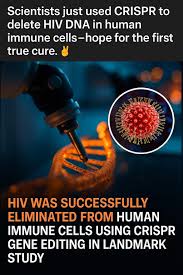HIV Cure: Breakthrough Advancements Paving the Way to End the Epidemic
Over 38 million people live with HIV today, and antiretroviral therapy keeps most of them healthy for decades. But popping pills every day for life? That’s no real fix. We need a cure to wipe out the virus for good and end this epidemic.
Think about it: ART suppresses the virus so well that folks on treatment can’t pass it on—that’s the U=U idea, undetectable equals untransmittable. Yet hidden pockets of HIV linger in the body, ready to bounce back if meds stop. This piece dives into the latest science pushing for a true HIV cure, from lab breakthroughs to real-world trials. You’ll see why experts believe we’re closer than ever to beating this thing.
The Scientific Landscape: Understanding the HIV Reservoir
The Latent Reservoir: Why Cures Remain Elusive
HIV hides smart. It slips into your DNA and goes quiet in resting CD4+ T-cells, those key immune fighters. This provirus stays dormant, dodging drugs that target active virus.
Standard ART can’t touch these sleeping spots. That’s why even after years on meds, the virus can wake up. Researchers call this the HIV latency problem—it’s the big wall blocking a full cure.
Latency means the virus integrates deep into host cells. It waits like a burglar in a safe house. Breaking this hideout takes new tricks, and teams worldwide chase them now.
Current Treatment Paradigm: ART and Viral Load Suppression
ART changed everything since the 1990s. It cuts viral loads to zero in blood for most users, letting people live normal lives. Over 28 million get this treatment globally, per health org reports.
Success builds hope for more. Viral suppression stops spread and boosts health, but it doesn’t erase the virus. That’s the base for cure work—strong control lets scientists test bold ideas safely.
Take the U=U message: it frees stigma for treated folks. Yet lifelong meds cost time and money. Cure research aims to build on ART wins without the daily grind.

Leading Strategies in HIV Cure Research
Shock and Kill (or Shock and Clear) Approaches
Imagine jolting a hidden enemy awake, then hitting it hard. That’s shock and kill. Latency-reversing agents, or LRAs, force dormant HIV out of hiding in those resting cells.
Once shocked, the virus shows up for immune attacks or targeted drugs to clear it. HDAC inhibitors tweak cell signals to wake the provirus. TLR agonists rev up body defenses too.
Trials mix these with ART to avoid rebound. Early tests show promise, but full clear-out needs fine-tuning. This method could pair with others for a one-two punch.
- Key LRAs in play: Protein kinase C activators and BET inhibitors.
- Goal: Wake virus without harming host cells.
- Challenge: Make sure the kill step wipes every last bit.
Gene Editing Technologies: CRISPR/Cas9 for Viral Removal
CRISPR acts like molecular scissors. It snips out HIV’s DNA from your genome with pinpoint aim. This gene editing for HIV targets the integrated provirus directly.
Labs use it on cells in dishes, then animals, to cut the virus free. No more hiding spots means no comeback. Early human tests focus on safety in small groups.
Picture editing a bad code from your life’s blueprint. That’s CRISPR’s power here. For HIV cure via CRISPR, results hint at long remissions without meds.
Trials from places like Excision BioTherapeutics show edited cells resisting infection. But scaling to whole bodies takes time. Still, it’s a game plan with real teeth.
Therapeutic Vaccines and Enhanced Immune Clearance
Regular vaccines prevent, but these fight back in infected people. Therapeutic vaccines train your immune system to spot and smash HIV cells on ART. They boost T-cells to hunt better.
Broadly neutralizing antibodies, or bNAbs, lock onto the virus like smart missiles. Infusions of these help clear infected spots. Adoptive T-cell transfer tweaks your own fighters for stronger attacks.
Why not prevention shots? These target cure by clearing reservoirs. Combo with ART shows virus drops in trials. It’s like arming your bodyguards for the final raid.
- Examples: Vaccines from Moderna or Gilead partners.
- Pairing: With bNAbs for wider coverage.
- Hope: Fewer cells mean easier full wipeout.
Progress from Clinical Trials and Milestones
The “Berlin Patient” and “London Patient” Precedents
Back in 2008, Timothy Ray Brown got a stem cell transplant for cancer. His donor had a rare CCR5 mutation that blocks HIV entry. He stopped meds and stayed clear— the first cure.
The London Patient followed in 2019, same deal. These cases prove functional cures work. Virus gone, no rebound, all from that gene tweak.
But risks loom large: transplants can kill via graft issues. They’re not for everyday use. Still, they light the path for safer methods.
Both men got elite donors with the delta 32 flaw. No HIV since. This CCR5 story sparks gene therapy dreams.
Ongoing Clinical Trials: Assessing Safety and Efficacy
Trials now test shock and kill in phase 2, watching for safe wake-ups. Gene edits enter early human phases, checking body reactions. Immune boosts like vaccines hit phase 1 too.
Safety first—phases build slow to spot side effects. Efficacy means measuring reservoir drops. Experts from ViiV Healthcare note cautious steps speed real wins.
One trial mixes LRAs with vaccines; another CRISPR in blood cells. Results vary, but some see lasting control off meds. It’s step by step, but momentum grows.
Researchers say, “We’re seeing signals of progress, but patience pays off.” Partnerships push faster. Watch for phase 3 news soon.
Addressing Implementation: Ensuring an Equitable Cure Future
Overcoming Biological Hurdles: Tissue Distribution and Resistance
HIV hides in gut, brain, and nodes—not just blood. Drugs must reach everywhere to hit reservoirs. Poor spread lets virus rebound fast.
Resistance pops up if partial cures miss spots. Like weeds in a garden, survivors regrow. New combos aim to cover all bases.
Teams model tissues in labs to test reach. Analogy: It’s chasing ghosts in every room of a house. Solving this makes cures stick.
Equity and Access: Making the Cure Reach Global Communities
High HIV spots in Africa and Asia need cures most. But costs and logistics block low-income areas. Plans must bake in fair prices from day one.
Advocacy groups push pharma for global trials. Partnerships like ViiV’s ensure diverse testing. Affordable generics follow success.
Think: No one left behind. Rollouts need local training and supply chains. Equity turns science into real change for all.
- Steps: Include voices from affected communities.
- Goal: Scale like ART did, but better.
- Tip: Support orgs funding access now.
Conclusion: Towards a Future Without HIV
Science teams chase HIV cure through shock and kill, CRISPR cuts, and immune boosts. From lab ideas to trial wins like the Berlin case, progress stacks up. ART sets the stage, but cures promise freedom.
Key point: Research shifted from dreams to hands-on tests. Another: Any win must stay safe, work wide, and reach everyone. Investments and team-ups keep us on track.
The end of HIV feels real. Stay informed, back the fight—together, we close in on zero.
Disclaimer :
This article is an aggregation of news and information sourced from various, different sources available on the public internet.News360 and its journalist team accept absolutely no responsibility, liability, or accountability for any reason whatsoever arising from the content of this article, including but not limited to, errors, inaccuracies, omissions, or any actions taken (or not taken) in reliance on the information presented herein. By reading this article, you acknowledge and agree that you use this information at your own risk. This content is provided for knowledge, information, and general awareness purposes only. It should not be considered as professional advice, a statement of fact, or an official publication of News360. Readers are strongly encouraged to verify all facts, claims, and information from the original, related sources cited or mentioned in this article.


Rajen Barman